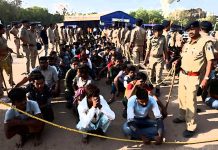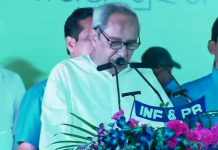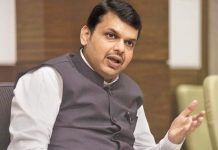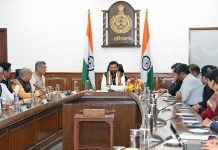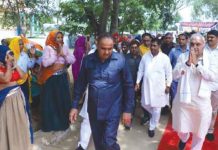 As the tightly-contested 2019 Lok Sabha elections draw to a close, the speculation among political parties has shifted to post-poll permutations and combinations that will decide which party or coalition gets to rule Delhi.
As the tightly-contested 2019 Lok Sabha elections draw to a close, the speculation among political parties has shifted to post-poll permutations and combinations that will decide which party or coalition gets to rule Delhi.
Though the exact numbers will be known only on May 23, when results for all the 543 Lok Sabha seats will be out, the ongoing discussions among political parties revolve around the likely scenarios that may include a UPA III kind of situation with the Congress emerging as the single largest party and being able to rally other like-minded parties or the BJP emerging as the single largest party but scoring less than the half way mark of 272 seats and forming an NDA government, or a repeat of 2014 when the saffron party got an absolute majority by winning 282 seats.
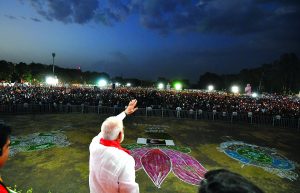 The third scenario appears to be the least probable with hints coming from within the ruling establishment including senior BJP leader Ram Madhav and Akali Dal leader Naresh Gujaral who have said the saffron party may not get a clear majority on its own.
The third scenario appears to be the least probable with hints coming from within the ruling establishment including senior BJP leader Ram Madhav and Akali Dal leader Naresh Gujaral who have said the saffron party may not get a clear majority on its own.
Recently, Congress chief Rahul Gandhi too claimed his party was winning and Prime Minister Narendra Modi was not coming back to power.
On their part, Congress strategists are hopeful of a 2004 like scenario when the grand old party was able to stitch the United Progressive Alliance which came to power at the centre under Prime Minister Manmohan Singh. The Congress had reached out to opposition parties in a major way in 2004 to oust the Atal Bihari Vajpayee government. The Congress-led coalition performed well during its first tenure and was re-elected by the voters in the 2009 national elections.
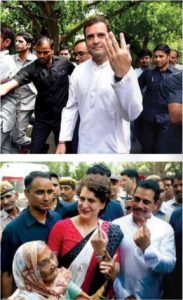 Ahead of the 2019 Lok Sabha polls, the Congress had started a nationwide effort to forge opposition unity by 2018 but lost momentum by year end as most parties said any such formation would be decided post-poll.
Ahead of the 2019 Lok Sabha polls, the Congress had started a nationwide effort to forge opposition unity by 2018 but lost momentum by year end as most parties said any such formation would be decided post-poll.
Picking up the thread towards the last leg of the ongoing national polls, the opposition parties appear to be working to a plan as they planned a mega meeting on May 21, two days before the Lok Sabha results, to discuss government formation. Though still tentative, the move is indicative of a regrouping with the aim of keeping the BJP out of power.
Talking about the first likely post-poll scenario, Congress insiders said they hope to comfortably cross the 125 seat mark, up from 44 in 2014, and then be in a position to anchor the like-minded parties and arrive at a workable coalition, whatever be its nomenclature.
Congress sources said though they were absolutely clear that party chief Rahul Gandhi would be their prime ministerial nominee, the issue was a touchy one and would be resolved post-poll in a spirit of friendship with the other partners. Keeping that in mind, Rahul carefully avoided giving a clear reply to the question before and even during the Lok Sabha poll campaign.
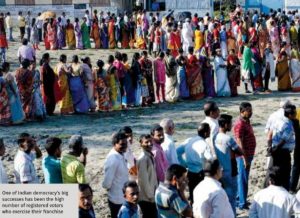 Congress strategists said they were aware of the prime ministerial ambitions of several key opposition leaders and realise that resolving the issue may prove to be a bit ticklish but expressed the hope that such discussions would not be allowed to fester for too long in case of a hung house.
Congress strategists said they were aware of the prime ministerial ambitions of several key opposition leaders and realise that resolving the issue may prove to be a bit ticklish but expressed the hope that such discussions would not be allowed to fester for too long in case of a hung house.
The recent hints of Samajwadi Party chief Akhilesh Yadav that he would prefer the next PM to be from UP and his alliance partner BSP chief Mayawati making no bones about her ambitions for the top post besides the self-projection of West Bengal chief minister and Trinamool Congress president Mamata Banerjee, could throw up a tricky round of negotiations. Congress insiders said these three leaders had played a crucial role in containing the BJP in their respective states and their role in the next government formation would be key.
To ensure all goes well, Congress sources said communication lines have remained functional with the like-minded parties during the campaign so that the shared objective of keeping the BJP out of power was not lost.
Though the Congress leadership was criticised for fighting against SP-BSP-RLD combine in UP and AAP in Delhi, party sources said they had lined up several pre-poll alliances across states and these would come handy after the Lok Sabha results were out.
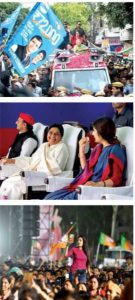 After sharing power with the Janata Dal-Secular in Karnataka, the Congress had formed major alliances in Tamil Nadu, Jharkhand, Bihar, Maharashtra and Jammu and Kashmir and is hopeful of getting the support of CPI-M, CPI, NCP, SP, BSP, RJD, RLD, DMK, NC, TDP, TMC, JMM, JVM, YSR Congress, RLSP and AIUDF among others.
After sharing power with the Janata Dal-Secular in Karnataka, the Congress had formed major alliances in Tamil Nadu, Jharkhand, Bihar, Maharashtra and Jammu and Kashmir and is hopeful of getting the support of CPI-M, CPI, NCP, SP, BSP, RJD, RLD, DMK, NC, TDP, TMC, JMM, JVM, YSR Congress, RLSP and AIUDF among others.
Discussions around the post-poll situations have started in the ruling establishment as well. Though PM Modi and BJP chief Amit Shah have been claiming this time the party would improve upon its score of 282 seats that it got in 2014, the second scenario is also being talked about.
If the BJP emerges as the single largest party but with less than 272 seats, it may get the support of parties like the JD-U, Shiv Sena, Akali Dal, AIADMK and even that of BJD, TRS and YSR Congress.
The KC Rao led Telangana Rashtra Samithi, which was once a UPA constituent had been dabbling with the BJP but has, of late, been making overtures towards the Congress. The YSR Congress, which was born in 2014 out of the grand old party, too may swing to any side.
Another issue the BJP and its ideological mentor RSS will have to deal with would be to decide on the continuity of PM Modi. That would depend much on where the saffron party finally lands, above 225 seats or below 200. In both cases, whether Modi would like head a coalition government remains to be seen given the free run that he enjoyed over the past five years.
Though Mayawati has charged that PM Modi tried to break the SP-BSP unity, sources said the BSP could switch sides post poll as she had the experience of working with the BJP earlier in UP.
While the BJP is going bullish on UP, which sends the largest 80 members to the Lok Sabha and plays a crucial role in deciding who gets to rule Delhi, the party had a pact with the Apna Dal and the Suheldev Bharatiya Samaj Party. In the opposition space, UP giants SP-BSP roped in Ajit Singh’s RLD while choosing to drop the Congress in their fight against the saffron party. The Congress however had a tie up with the Krishna Devi faction of Apna Dal and left two seats for them. Together the mahagathbandhan hopes to bring the BJP significantly down from 71 seats in 2014.
Similarly in Bihar, which sends 40 members to the Lok Sabha, the BJP stooped to offer 17 seats to Nitish Kumar’s JD-U and left 6 seats for Ram Vilas Paswan’s LJP. The opposition alliance in the state has brought together the RJD, Congress, Sharad Yadav’s LJD, CPI, HAM and RLSP and hopes to contain the NDA.
Congress managers said they see a return of the 2004 like situation because of the high-pitched BJP campaign which tried to cover the Modi government’s failures in delivering on the 2014 promises and the grand old party’s main poll plank of justice for all highlighting the lack of jobs, suffering small businesses and widespread rural distress.
“In 2004, then party chief Sonia Gandhi lead a nationwide campaign based on social welfare to deflate the BJP’s India Shining propaganda…the result was for all to see…the story will repeat itself in 2019 as the Modi government has paid only lip service to rural India,” said a senior AICC functionary.
The Congress, which had won 145 seats in 2004, could be close to that range this time, he claimed citing an internal assessment after five rounds of polling in the ongoing Lok Sabha elections. The BJP was close behind with 138 seats in 2004 but the Left parties with 60 seats supporting the Congress from outside tilted the balance in favour of the grand old party. Riding on the successful run of UPA I, the Congress tally went up to 206 in the 2009 national polls only to come crashing down to just 44 in 2014.
Party insiders said senior leader and star campaigner Priyanka Gandhi Vadra’s comments of having fielded candidates in UP to help the gathbandhan wherever the Congress did not have a strong candidate should be seen in the light of the opposition parties working to a plan to keep the BJP at bay. Citing the grand old party’s sacrifice in offering the post of chief minister in Karnataka to much smaller JD-S, the Congress strategists said they had shown a spirit of being accommodative to the aspirations of the regional parties and will make space for them wherever needed. But at the same time, Rahul’s decision to join the fight in UP even at the cost of making the contest there three cornered stemmed from a deep desire to revive the party nationally.
Commenting on the reports that the regional outfits may this time come together to keep the national parties away, party sources said there was nothing wrong in harbouring such aspirations in a federal system but the longevity of such formations was always a matter of doubt and may not augur well for the country’s progress.
In the same breath, they reiterated that everything would depend on the actual numbers available on May 23 when the Indian electorate would have
spoken their mind.
letters@tehelka.com

